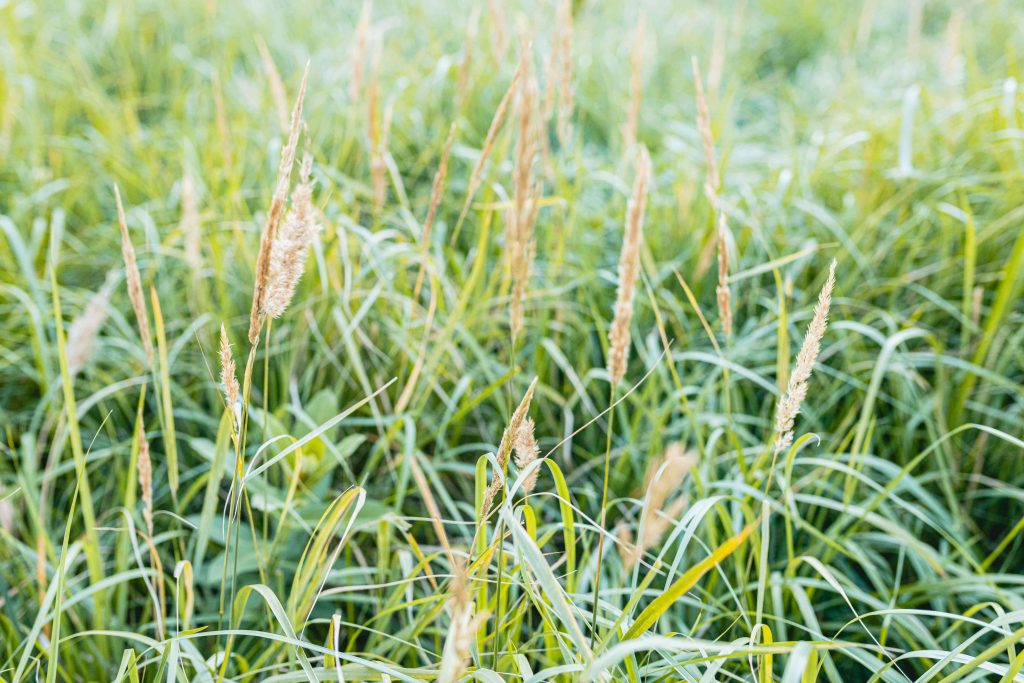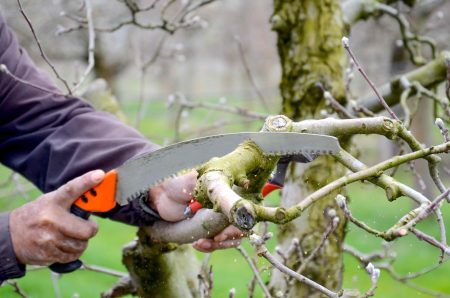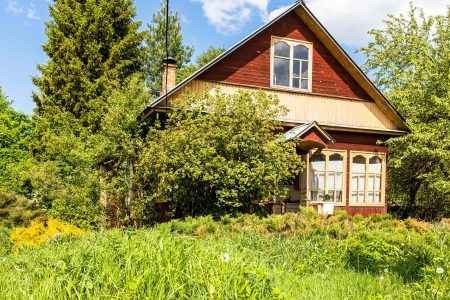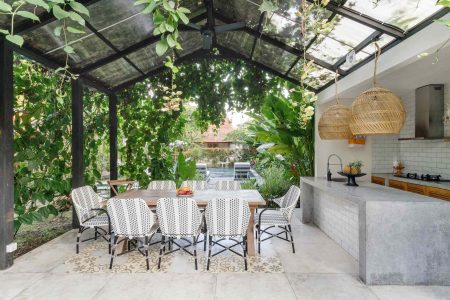Ornamental grass can be used in landscapes for nonstop performance, strength, and visual impact. Unlike lawn or turfgrass varieties, ornamental grasses are meant to grow—not be cut or mown—and most are not used as ground covers. Once you start landscaping with ornamental grasses you will be amazed by how many varieties, sizes, shapes, and colors are available. You can also use an ornamental grass in a container garden, as part of the thriller, filler, spiller theory. Another benefit of ornamental grasses is that many types are deer resistant.
Here are 12 of the most popular ornamental grasses to grow.
-
01
of 12Blue Fescue
Blue fescue (Festuca glauca) has silvery blue foliage and pale green flowers that turn buff-colored as they mature. It also grows somewhat low. Some fescues are grown as lawns, such as the clumping red fescue. To add more confusion, turf fescues are classified as tall fescues, the seeds of which were brought to the United States from Europe in the early 19th century.
But in the world of ornamental grasses, fast-growing fescues are considered low-growers and are often used as edgings, borders, and ground covers. In addition to blue fescue, other popular ornamental fescues include atlas fescue (Festuca mairei), California fescue (Festuca californica), and sheep fescue (Festuca ovina).
- Name: Blue fescue (Festuca glauca)
- USDA Hardiness Zones: 4 to 8
- Light: Full sun
- Soil Needs: Dry to medium moisture, well-drained
- Deer Resistant: Yes
-
02
of 12Mexican Feather Grass
Mexican feather grass (Nassella tenuissima or Stipa tenuissima) sways gracefully in the wind with its feathery flower panicles. But this moderate-growing grass tends to show up in gardens and other areas all over town. Mexican feather grass is even grown on green roofs. The seeds are at the very tips of the featherlike “blades,” which wave in the gentlest of winds. Mexican feather grass also spreads. It can show up all over the yard, in sidewalk cracks, and down the street in neighbors’ yards.
Mexican feather grass survives in dry conditions and thrives just fine after being cut back. Some native plant organizations consider it invasive. If you can contain it, though, this grass is quite lovely, especially when it blows in the wind.
- Name: Mexican feather grass (Nassella tenuissima or Stipa tenuissima)
- USDA Hardiness Zones: 6 to 10
- Light: Full sun to part shade
- Soil Needs: Well-drained, loamy, acid; tolerant of sand and clay
- Deer Resistant: Yes
-
03
of 12Japanese Forest Grass
Japanese forest grass (Hakonechloa macra) comes from areas around Mt. Hakone in Japan and is popular for its beautiful and exotic clumping habit and striking foliage, which turns orange or bronze in the fall. Cultivars such as ‘All Gold’ and ‘Aureola’ have variegated green and gold leaves. This deciduous grass can be identified by its slender stems, which look like tiny bamboo stalks. It is striking in containers or as a color accent in borders, especially with darker green plants or those with purple flowers. It requires regular watering, weekly, or more often during hotter temperatures and it is extremely slow growing.
- Name: Japanese forest grass (Hakonechloa macra)
- USDA Hardiness Zones: 5 to 9
- Light: Part shade
- Soil Needs: Moist, well-drained, humusy
- Deer Resistant: Yes
-
04
of 12Zebra Grass
Zebra grass is known botanically as Miscanthus sinensis ‘Zebrinus’. It is also sometimes called porcupine grass (Miscanthis sinensis ‘Strictus’). This green and pale yellow upright beauty is somewhat fast-growing, dies back in winter, then comes back strong in the spring, whether or not it has been trimmed. It can grow 5 feet tall or taller and about 5 feet wide, even if you prune it during its growing season, which is spring and summer in the western United States.
Depending on what you pair zebra grass with, it can have an exotic, tropical look and is striking planted near broad-leafed tropical plants with colorful flowers such as canna, ginger, hibiscus, and plumeria.
- Name: Zebra grass (Miscanthus sinensis ‘Zebrinus‘)
- USDA Hardiness Zones: 5 to 9
- Light: Full sun
- Soil Needs: Any type: chalk, clay, loam, sand
- Deer Resistant: Yes
Continue to 5 of 12 below. -
05
of 12Bamboo
It is easy to forget that bamboo (Bambusa spp. or Phyllostachys spp.) is actually a member of the grass family. Bamboo grows upright fast and spreads quickly (sometimes too much). It requires a regular watering schedule during the first growing season to establish a deep, extensive root system. A native of China, bamboo was introduced to the Western world sometime after the mid-19th century.
Bamboo naturally grows in warm climates, but you can also find cold-hardy varieties, such as Bisetti (hardy to zone 4), Nuda (hardy to zone 4), giant leaf (hardy to zone 5), and Spectabilis (hardy to zone 5). In very cold areas, bamboo canes often die back in winter, but the roots survive. Some types are evergreen in zones 5 and above.
Warning
Some types of bamboo are considered invasive in parts of the United States, but not in others. For example, golden bamboo is considered invasive in some southern states, including Texas and Florida.
- Name: Bamboo (Bambusa spp. or Phyllostachys spp.)
- USDA Hardiness Zones: 4 and up, depending on variety
- Light: Part shade
- Soil Needs: Loose, well-drained, slightly acidic
- Deer Resistant: Yes
-
06
of 12Purple Fountain Grass
Purple fountain grass (Pennisetum setaceum ‘Rubrum’) has become an extremely popular and fast-growing landscaping plant in both residential and commercial settings. It has a striking, fountain-like form, reddish-purple color, and feather-like flowers that make it appealing from a distance and for up-close viewing. It is hardy only to zone 9; in cold-winter areas, it is typically grown as an annual.
The mature size of this grass is fairly predictable—usually 2 to 5 feet tall and 2 to 4 feet wide. While it is considered low-maintenance, that is often because gardeners and landscape maintenance workers cut it to about a foot high when it starts to look dry in late fall—and it resembles a cropped bale of hay.
Purple fountain grass can almost be a year-round performer if you treat it right. When it starts to spread out and the feathered flowers resemble wheat, it is time to deadhead the grass. In a garden, it looks striking next to lime green and silver grasses and plants such as oat grass or sweet potato vine. It is also deer-resistant and drought-tolerant once established. It is especially beautiful in fall container arrangements and autumn gardens.
- Name: Purple fountain grass (Pennisetum setaceum ‘Rubrum’)
- USDA Hardiness Zones: 9 to 10
- Light: Full sun to part shade
- Soil Needs: Medium moisture, well-drained
- Deer Resistant: Yes
-
07
of 12New Zealand Flax
Like fountain grass, New Zealand flax (Phormium tenax) has become increasingly popular in residential and commercial applications but it is slower growing. Possessing a similar deep-red, purplish-bronze color, New Zealand flax’s leaves are broader or more strap-like than the finer fountain grass. It also tends to get taller, reaching a height of 5 feet or more, and about 4 feet wide. This grass must be de-clumped every few years. While this is not an easy task, after you have separated the clumps and replanted them elsewhere in the garden, you will have gained new plants for free.
- Name: New Zealand flax (Phormium tenax)
- USDA Hardiness Zones: 8 to 10
- Light: Full sun to part shade
- Soil Needs: Rich, moist, well-drained
- Deer Resistant: Yes
-
08
of 12Japanese Blood Grass
Imperata cylindrica ‘Rubra’ or Japanese blood grass is a fast-growing and colorful red, yellow, and green grass that is native to Australia, Africa, Southeast Asia, India, Micronesia, and Melanesia. Upright clumps spread slowly underground by runners. It grows best in damp, rich soil and likes moisture during the hottest months. If the soil is too dry, it can fade away or die. Despite its beauty, some regions consider it invasive. It is also called cogon grass.
Warning
Imperata cylindrica is an invasive species that, according to U.S. federal law, is illegal to grow without a permit. However, the ‘Rubra’ cultivar is relatively less aggressive and is sold in garden centers in many cold-winter areas, where it is easier to control than in warmer zones. To be safe, confirm that your state’s laws permit the use of this grass before buying or planting it.
- Name: Japanese blood grass (Imperata cylindrica ‘Rubra’)
- USDA Hardiness Zones: 5 to 9
- Light: Full sun to part shade
- Soil Needs: Moist, well-drained
- Deer Resistant: Yes
Continue to 9 of 12 below. -
09
of 12Blue Oat Grass
Blue oat grass (Helictotrichon sempervirens, Avena candida) is a fast-growing ornamental that shoots up to about 3 to 6 feet in height and 1 to 3 feet in width. It can be identified by its fountainlike silver-blue blades with a light beige dome that appears in the summer. Blue oat grass likes full sun and weekly water. It can be salt- and drought-tolerant after it is established. The grass is great for rock gardens with succulents, native landscaping, borders, and mass plantings.
- Name: Blue oat grass (Helictotrichon sempervirens, Avena candida)
- USDA Hardiness Zones: 4 to 8
- Light: Full sun
- Soil Needs: Medium moisture, well-drained
- Deer Resistant: Yes
-
10
of 12Pink Muhly Grass
Pink muhly grass is also known as sweetgrass, gulf muhlygrass, mist grass, hairawn muhly, and the botanical name, Muhlenbergia capillaris. It is named after botanist/chemist/mineralogist Henry Muhlenberg. This ornamental grass is somewhat slow growing but it is admired for its fall- and winter-blooming pink flowers or featherlike plumes. In landscape design, muhly grass looks best in large or mass clumps in perennial borders or native gardens, where its wispy pink blooms offer plenty of visual impact.
- Name: Pink muhly grass (Muhlenbergia capillaris)
- USDA Hardiness Zones: 5 to 9
- Light: Full sun to part shade
- Soil Needs: Medium moisture, sandy or rocky, well-drained
- Deer Resistant: Yes
-
11
of 12Egyptian Papyrus
Cyperus papyrus is sometimes called an African native grass or a grass-like plant. Egyptian Papyrus fits nicely into the ornamental grass category. These exotic beauties can grow up to 72 inches or more, they like moist soil, and they can thrive in a water garden. In regions that do not experience freezing temperatures, this grass is a perennial.
- Name: Papyrus (Cyperus papyrus)
- USDA Hardiness Zones: 8 to 11
- Light: Full sun
- Soil Needs: Rich, wet
- Deer Resistant: Yes
-
12
of 12Black Mondo Grass
Black mondo grass (Ophiopogon planiscapus ‘Nigrescens’) grows slowly and only to about 8 inches high but is a spreader, making it an ideal ground cover. Not actually black, it is more of a dark greenish-purple; it looks striking when paired with light lavender, chartreuse, or lime-colored plants. It likes partial to full sun and moist, well-drained soil.
- Name: Black mondo grass (Ophiopogon planiscapus ‘Nigrescens’)
- USDA Hardiness Zones: 6 to 9
- Light: Full sun to part shade
- Soil Needs: Moist, well-drained, humusy, slightly acid
- Deer Resistant: Yes
-
Do ornamental grasses need to be cut back every year?
Pruning needs depend on the species. But in general, cutting back ornamental grasses can restore their vigor and help prevent them from toppling over. Many people do this in the early spring because lots of ornamental grass species provide winter interest and food for wildlife.
-
Can you split ornamental grasses?
You may gently dig up a mature clump of ornamental grasses and tease apart the roots to create separate plant sections. Then, replant the sections in suitable growing sites. Dividing mature clumps every few years is a good way to maintain healthy and vigorous growth.
-
Will ornamental grasses survive winter?
Look for an ornamental grass species that is suitable for your growing zone, and it should do fine over the winter. Many species go dormant during the winter months and only require a small amount of water to prevent the soil from fully drying out.
Read the full article here









